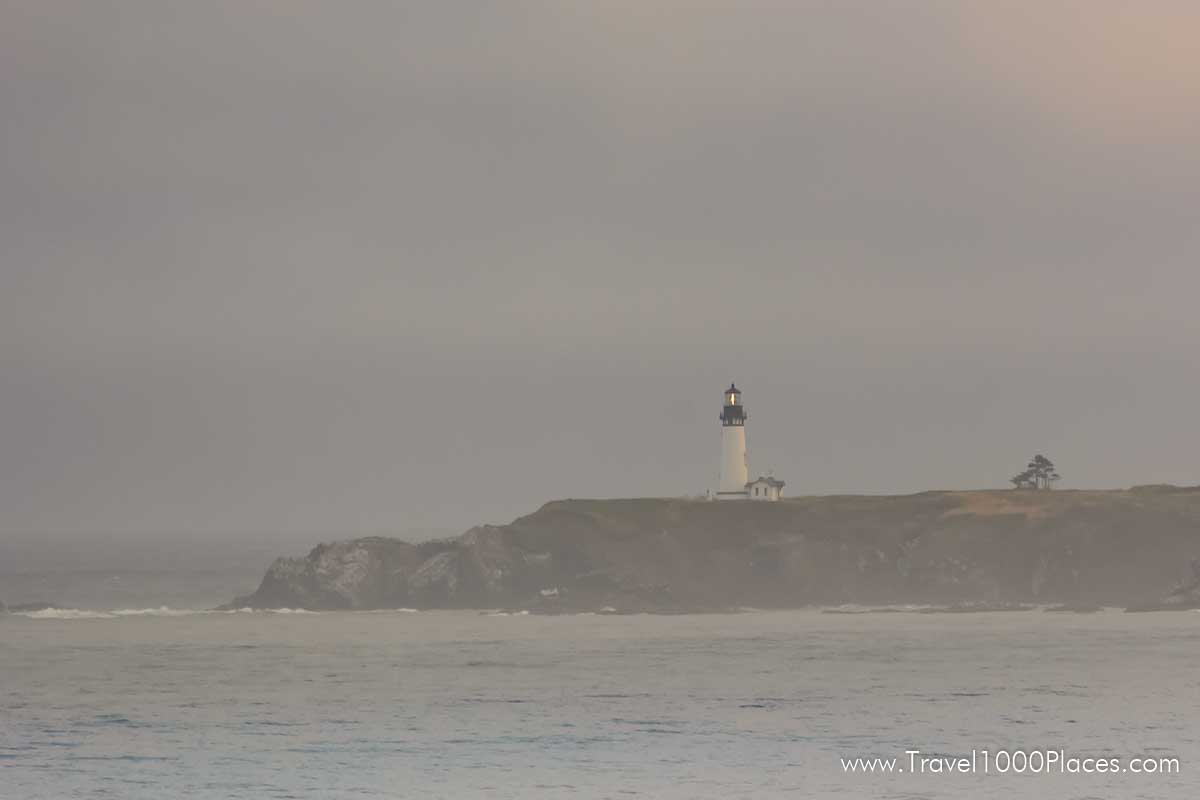![Yaquina Head Lighthouse, Oregon, USA [photo: frankschrader.us]](https://www.travel1000places.com/wp-content/uploads/2020/08/OR-yaquina-head-lighthouse-004.jpg)
![Yaquina Head Lighthouse, Oregon, USA [photo: frankschrader.us]](https://www.travel1000places.com/wp-content/uploads/2020/08/OR-yaquina-head-lighthouse-002.jpg)


The nightly vigil of watching the light is gone as are the resident keepers and their quarters, but the staff of the Bureau of Land Management now responsible for the tower, guide you through the lighthouse with tales of yesteryear.
Even before you enter the structure and stroll across its unique marble floor, you are aware of its historic significance. The “1872” above the front door signifies that it was Oregon’s fifth lighthouse built to guide mariners along the coast and into safe havens.
As you climb the 110 of 114 steps of Oregon’s tallest lighthouse at 93 feet, the presence of people who watched the light fills the tower with stories of what keeper life was like at Yaquina Head. You get a sense of what it was like to carry supplies up the spiral staircase as you breathe a little deeper.
At the time it was built, the area was much like a wilderness. The road to the lighthouse was very primitive, so a number of the construction materials had to come by way of sea. The Lighthouse Tender Shubrick, a side-wheel steamer, was used to off-load supplies and workers.
With construction completed, the fixed white light was illuminated on the night of August 20, 1873, when Head Keeper Fayette Crosby lit the 4-wick lamp fueled by lard oil. The massive white conical shaped tower was built with double-walled brick, for insulation and dampness protection. The tower’s 370,000 bricks and ironwork were made in Oregon.
It was equipped then as it is today with a first order Fresnel lens. It was manufactured in Paris in 1868 by Barbier & Fenestre, and shipped from France to Panama, transported across the isthmus, then shipped again to Oregon.
Along with the construction of the lighthouse, a large dwelling for two keepers and their families was built east of the tower. There were also a smaller keeper’s dwelling, stable, workshop, and a garden area.
The 1930’s brought many changes to the light station. The light’s power source was changed from oil to electricity. The light character was changed from a fixed to a flashing pattern called a ‘signature’, unique to each lighthouse. Yaquina Head’s pattern is two seconds on, two seconds off, two on, fourteen off, and then repeats.
Through the years new structures replaced the old. But, as one retired lighthouse keeper put it, “the buildings left a lot to be desired, as winds would come whistling through the buildings with enough force to lift a catalog off the floor”. Eighty miles per hour winds are not uncommon at the headland, especially during the wet winter months.
In 1966, the era of the lighthouse keeper at Yaquina Head ended when the light was automated. With the 1000-watt lamp generating over 130,000 candlepower to be seen about19 miles out to sea, a resident keeper was no longer need on the grounds. The unoccupied quarters eventually fell into disrepair and were removed in 1984.
History
Jutting into the Pacific Ocean, Yaquina Head is battered and scoured by waves, wind and rain. The headland is a lava flow which originated 14 million years ago in eastern Washington and Oregon and spread 300 miles before reaching the ocean. The lava then cooled to form basalt rock which refuses to be worn away as quickly as the surrounding sandstone and other rock. The bordering sandy beaches continue to recede, while Yaquina Head endures.
People have visited Yaquina Head for thousands of years. Layers of shell debris attest to native people’s taste for the mussels and other seafood found here more than 4,000 years ago. Oregon’s tallest and second oldest continually active lighthouse has illuminated this promontory since 1873. The hard basalt which forms the headland was quarried and crushed to build local roads and driveways.
In 1980, Congress created the 100-acre Yaquina Head Outstanding Natural Area. It is managed by the Bureau of Land Management to protect its unique scenic, scientific, educational and recreational values for your enjoyment and the enjoyment of future generations. Cooperating in this endeavor are the State of Oregon, the U.S. Fish and Wildlife Service and the U.S. Coast Guard.
Hours of Operation
Park Grounds:
The entrance gate is open from sunrise to sunset every day of the year.
Map
Official Websites
Yaquina Head Lighthouse (BLM.gov)
Friends of Yaquina Lighthouses (https://www.yaquinalights.org/)

